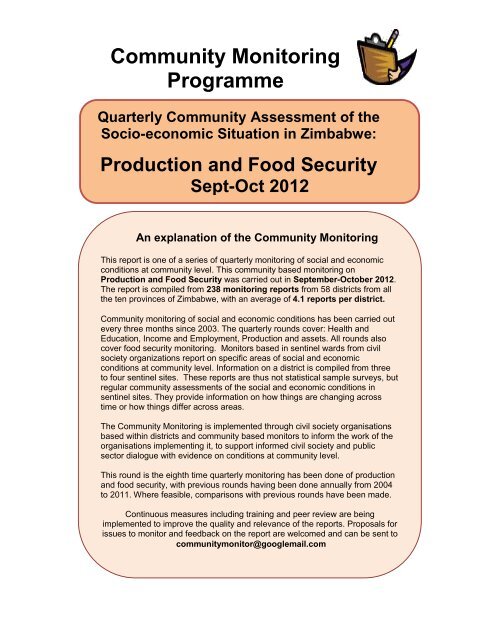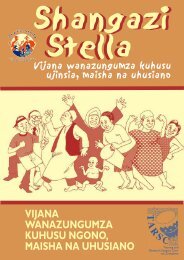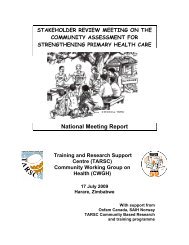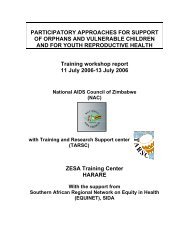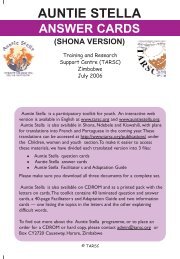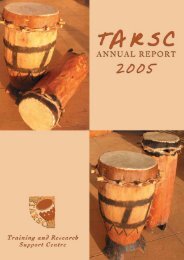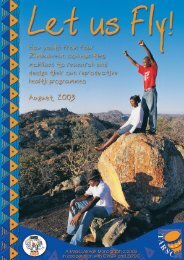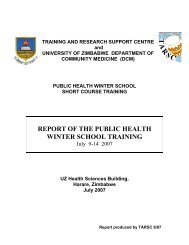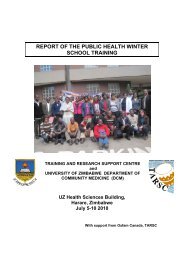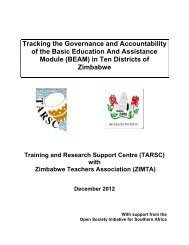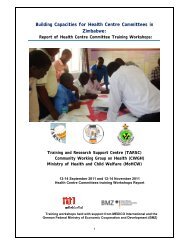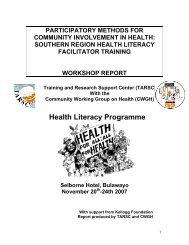CMP Prod Oct2012.pdf - Training and Research Support Centre
CMP Prod Oct2012.pdf - Training and Research Support Centre
CMP Prod Oct2012.pdf - Training and Research Support Centre
Create successful ePaper yourself
Turn your PDF publications into a flip-book with our unique Google optimized e-Paper software.
Community Monitoring<br />
Programme<br />
Quarterly Community Assessment of the<br />
Socio-economic Situation in Zimbabwe:<br />
<strong>Prod</strong>uction <strong>and</strong> Food Security<br />
Sept-Oct 2012<br />
An explanation of the Community Monitoring<br />
This report is one of a series of quarterly monitoring of social <strong>and</strong> economic<br />
conditions at community level. This community based monitoring on<br />
<strong>Prod</strong>uction <strong>and</strong> Food Security was carried out in September-October 2012.<br />
The report is compiled from 238 monitoring reports from 58 districts from all<br />
the ten provinces of Zimbabwe, with an average of 4.1 reports per district.<br />
Community monitoring of social <strong>and</strong> economic conditions has been carried out<br />
every three months since 2003. The quarterly rounds cover: Health <strong>and</strong><br />
Education, Income <strong>and</strong> Employment, <strong>Prod</strong>uction <strong>and</strong> assets. All rounds also<br />
cover food security monitoring. Monitors based in sentinel wards from civil<br />
society organizations report on specific areas of social <strong>and</strong> economic<br />
conditions at community level. Information on a district is compiled from three<br />
to four sentinel sites. These reports are thus not statistical sample surveys, but<br />
regular community assessments of the social <strong>and</strong> economic conditions in<br />
sentinel sites. They provide information on how things are changing across<br />
time or how things differ across areas.<br />
The Community Monitoring is implemented through civil society organisations<br />
based within districts <strong>and</strong> community based monitors to inform the work of the<br />
organisations implementing it, to support informed civil society <strong>and</strong> public<br />
sector dialogue with evidence on conditions at community level.<br />
This round is the eighth time quarterly monitoring has been done of production<br />
<strong>and</strong> food security, with previous rounds having been done annually from 2004<br />
to 2011. Where feasible, comparisons with previous rounds have been made.<br />
Continuous measures including training <strong>and</strong> peer review are being<br />
implemented to improve the quality <strong>and</strong> relevance of the reports. Proposals for<br />
issues to monitor <strong>and</strong> feedback on the report are welcomed <strong>and</strong> can be sent to<br />
communitymonitor@googlemail.com
<strong>Prod</strong>uction <strong>and</strong> Food Security<br />
September-October 2011<br />
Summary of Findings<br />
Returns from <strong>Prod</strong>uction<br />
Small scale farming <strong>and</strong> informal vending continue to be the main production<br />
activities. Formal <strong>and</strong> informal manufacturing, formal retail <strong>and</strong> large scale farming<br />
remained at lower levels. Informal vending has risen sharply since 2007, with sale of<br />
clothes, building materials, electrical gadgets, food items - including alcohol - <strong>and</strong><br />
agricultural commodities.<br />
Women are reported to be more involved in informal vending <strong>and</strong> men more involved in<br />
the other production activities, particularly those associated with more secure incomes.<br />
For small scale agriculture, the majority of households were reported to have limited<br />
access to l<strong>and</strong>, with a small improvement in access in 2012, <strong>and</strong> with greater access to<br />
l<strong>and</strong> in men than in women.<br />
Fertilizer <strong>and</strong> maize seed are reported to be available in more than two thirds of sites,<br />
with rising prices for fertilizer <strong>and</strong> lower prices reported for maize seed in 2012<br />
compared with 2011.<br />
The availability of groundnut <strong>and</strong> sorghum seed in sites is reported to be relatively low,<br />
having fallen after 2009 <strong>and</strong> costs for these seed to be higher than for maize seed,<br />
possibly inhibiting use of sorghum despite its resilience in low rainfall areas.<br />
Across provinces, access to tillage <strong>and</strong> credit was lower in Masvingo <strong>and</strong> Matabelel<strong>and</strong><br />
North, <strong>and</strong> to irrigation lower in Manical<strong>and</strong> <strong>and</strong> Matabelel<strong>and</strong> South, <strong>and</strong> men were<br />
reported to have better access to inputs than women. Community monitors reported that<br />
when prices for crops such as maize are low, <strong>and</strong> input costs high, they struggle to make<br />
adequate income to meet needs such as health <strong>and</strong> education fees.<br />
Household food security<br />
Communities are reported to be almost entirely relying on commercial sources of food,<br />
with only eight percent of the sites reporting consumption of own produce. The big fall in<br />
own produce as a source since 2009 may reflect a shift away from food production<br />
towards other cash crops, but it also appears that returns from sales of other crops may<br />
not match costs of commercial foods for many households as sale of assets to purchase<br />
food was reported to be happening in almost all (94%) sites.<br />
Food is generally widely available, with a small increase in prices.<br />
Nevertheless the share of sites where households were reported to have no food stocks<br />
remained relatively high (over 60%) <strong>and</strong> has been deteriorating since 2009.<br />
If the returns from the other production activities are not adequately supporting food<br />
security, as it appears from the evidence, then more focus needs to be given to<br />
incentives for food production, such as in making inputs more affordable for food<br />
producers, especially women producers.<br />
Environments for health<br />
Nearly a third (30%) of sites report less than a quarter of the households in their site<br />
having access to safe water.<br />
There has also been a small reported improvement in access to safe sanitation during<br />
2012, although still with 20% of sites reporting less than a quarter of sites having access<br />
to safe sanitation.<br />
1
Returns from <strong>Prod</strong>uction<br />
Successful production is an important contributor to improved household wealth, incomes,<br />
<strong>and</strong> food security. How are households recovering after the prolonged period of economic<br />
decline in Zimbabwe in the 2000s? Are they accessing the resources needed for production?<br />
This round of monitoring has tracked performance on indicators of production <strong>and</strong> food<br />
security to help in answering these questions.<br />
What production activities are households engaged in? The community monitoring reports<br />
indicate that small scale farming <strong>and</strong> informal vending continue to be the main production<br />
activities. Formal <strong>and</strong> informal manufacturing, formal retail <strong>and</strong> large scale farming<br />
remained at lower levels, with unchanged frequency of reporting since 2011 (See Figure<br />
1). Informal vending has risen sharply since 2007, <strong>and</strong> although fewer sites reported it as<br />
the main activity in 2011, it rose again in frequency in 2012. Community monitors<br />
reported that vending in informal markets includes sale of clothes, building materials,<br />
electrical gadgets, food items including alcohol <strong>and</strong> agricultural commodities.<br />
Women are reported to be more involved in informal vending <strong>and</strong> men more involved in the<br />
other production activities, particularly those associated with more secure incomes (formal<br />
manufacture, formal marketing <strong>and</strong> large scale farming). Men have become more involved<br />
in small scale farming since 2011 (Table 1).<br />
Table 1: Percent of sites reporting production activity by gender M=Men, F=Women<br />
Small scale<br />
farming<br />
Large scale<br />
farming<br />
Formal<br />
manufacturing<br />
Informal<br />
manufacturing<br />
Formal<br />
marketing<br />
Informal<br />
vending<br />
Province<br />
M F M F M F M F M F M F<br />
Sept 2012 68 66 24 12 23 10 32 12 16 12 55 63<br />
Sept 2011 60 54 27 7 21 13 30 12 17 9 43 56<br />
Sept 2010 67 70 13 6 17 7 40 12 14 13 60 74<br />
Sept 2009 50 58 17 7 25 14 50 42 43 30 47 64<br />
Total Sept 2012 67 18 16 22 14 59<br />
2
Securing meaningful income from small scale farming <strong>and</strong> informal vending depends on<br />
improved access to production inputs, improved outputs from production <strong>and</strong> returns from<br />
the market. How well are households faring in these areas?<br />
For small scale<br />
agriculture, the<br />
monitoring reports show<br />
that while the majority of<br />
households had limited<br />
access to l<strong>and</strong>, there<br />
was a small<br />
improvement in access<br />
in 2012. This was<br />
particularly the case for<br />
men, whose access to<br />
l<strong>and</strong> is greater than for<br />
women (See Figure 2)<br />
Lower access to l<strong>and</strong> is<br />
reported in Masvingo<br />
<strong>and</strong> Matabelel<strong>and</strong> North<br />
(Table 2)<br />
Table 2: Reported access to adequate l<strong>and</strong>, M= Male, F = Female<br />
% sites reporting share of households having access to l<strong>and</strong><br />
None Few Many All<br />
Province<br />
F M F M F M F M<br />
Bulawayo 21 17 28 31 3 7 0 0<br />
Harare 0 0 0 0 3 3 0 0<br />
Manical<strong>and</strong> 0 0 35 4 65 96 0 0<br />
Mashonal<strong>and</strong> Central 0 0 33 0 57 90 0 0<br />
Mashonal<strong>and</strong> East 0 10 24 10 76 81 0 0<br />
Mashonal<strong>and</strong> West 0 0 30 13 70 87 0 0<br />
Masvingo 14 7 79 14 7 79 0 0<br />
Matabelel<strong>and</strong> North 13 6 75 13 13 81 0 0<br />
Matabelel<strong>and</strong> South 0 0 33 11 67 89 0 0<br />
Midl<strong>and</strong>s 0 0 23 19 77 81 0 0<br />
Sub Total Sept 2012 5 4 34 12 41 64 0 0<br />
Sub Total Sept 2011 8 11 49 31 35 37 0 3<br />
Sub Total Sept 2010 21 15 45 27 12 31 0 3<br />
Sub Total Sept 2009 18 14 57 39 6 23 0 4<br />
Total Sept 2012 5 23 53 0<br />
Total Sept 2011 10 40 36 1<br />
Total Sept 2010 18 36 22 2<br />
Total Sept 2009 17 48 15 2<br />
“Not rural” responses make up the difference in total percentages in all provinces<br />
“Farmers are not sure about the rains thus making them slow in preparing the l<strong>and</strong>.”<br />
Masvingo<br />
In relation to inputs, this round of monitoring found that the price of fertilizer in 2012 was<br />
reported to be slightly higher in 2012 than in 2011, <strong>and</strong> the price of maize seed to be<br />
slightly lower in 2012 compared to 2011 (See Figure 3). The monitors report that a<br />
number of new seed varieties are now being sold, particularly for maize.<br />
3
Fertilizer <strong>and</strong> maize seed are reported<br />
to be available in more than 69% <strong>and</strong><br />
73% of sites, <strong>and</strong> have remained at<br />
levels of above 60% sites reporting<br />
availability since September 2009<br />
(See Table 3). However rising prices<br />
of fertilizer may mean that poorer<br />
farmers may not be able to afford to<br />
buy inputs in adequate quantities,<br />
affecting their yields (<strong>and</strong> keeping<br />
them in poverty).<br />
As shown in Figure 4, reported<br />
availability of groundnut <strong>and</strong> sorghum<br />
seed in sites is still relatively low,<br />
having fallen after 2009. Reported<br />
availability of draught power <strong>and</strong> credit<br />
have stayed at relatively constant<br />
levels (<strong>and</strong> reported to be available in<br />
above 50% of sites. The costs for a<br />
10kg bag of sorghum <strong>and</strong> groundnut<br />
seed are reported by monitors to be<br />
relatively high for farmers, with a 10kg<br />
bag of sorghum costing $20.10 <strong>and</strong> a<br />
10 kg bag of groundnut seed costing<br />
$19.80. With these costs higher than<br />
maize seed they may inhibit use of<br />
these crops, such as of sorghum in<br />
low rainfall areas.<br />
‘The Government should subsidies the<br />
cost of seed <strong>and</strong> fertilizer. People did<br />
not harvest anything last year <strong>and</strong><br />
they don’t have income to buy inputs’<br />
Monitor, Midl<strong>and</strong>s<br />
Table 3: Reported availability of fertiliser <strong>and</strong><br />
maize seed<br />
% of sites reporting on<br />
availability of<br />
Province<br />
Fertilizer Maize seed<br />
Bulawayo 62 72<br />
Harare 82 79<br />
Manical<strong>and</strong> 78 78<br />
Mashonal<strong>and</strong> Central 71 67<br />
Mashonal<strong>and</strong> East 76 86<br />
Mashonal<strong>and</strong> West 61 74<br />
Masvingo 71 68<br />
Matabelel<strong>and</strong> North 63 63<br />
Matabelel<strong>and</strong> South 56 67<br />
Midl<strong>and</strong>s 65 69<br />
Total Sept 2012 69 73<br />
Total Sept 2011 77 80<br />
Total Sept 2010 65 91<br />
Total Sept 2009 63 69<br />
Total Nov 2008 4 4<br />
“Not rural” responses make up the difference in total<br />
percentages in all provinces<br />
4
Across provinces, access to tillage <strong>and</strong> credit was lower in Masvingo <strong>and</strong> Matabelel<strong>and</strong><br />
North, <strong>and</strong> to irrigation lower in Manical<strong>and</strong> <strong>and</strong> Matabelel<strong>and</strong> South, The community<br />
reports indicated that men generally have better access to inputs than women, particularly in<br />
relation to access to credit <strong>and</strong> tillage (Table 4). Community monitors reported that when<br />
prices for crops such as maize are low, <strong>and</strong> input costs high, they struggle to make adequate<br />
income to meet needs such as health <strong>and</strong> education fees.<br />
‘The prices offered for the crops are low, people cannot get income from farming to meet<br />
school fees <strong>and</strong> food costs”<br />
Monitor, Mashonal<strong>and</strong> Central<br />
Table 4: Reported access to agricultural inputs in rural provinces<br />
% sites reporting response on share of households with access<br />
None Few Many All<br />
Province<br />
Women Men Women Men Women Men Women Men<br />
Tillage/Draught Power<br />
Total Sept 2012 17 8 58 23 5 49 0 0<br />
Total Sept 2011 22 13 47 22 14 45 0 0<br />
Total Sept 2010 24 21 45 10 10 41 0 2<br />
Total Sept 2009 19 15 54 32 5 32 1 0<br />
Credit for farming<br />
Total Sept 2012 38 17 40 49 1 15 0 0<br />
Total Sept 2011 37 21 39 44 6 17 1 0<br />
Total Sept 2010 47 34 35 39 1 6 0 0<br />
Total Sept 2009 30 21 50 54 1 6 0 1<br />
Irrigation<br />
Total Sept 2012 59 47 21 32 0 1 0<br />
Total Sept 2011 50 39 30 37 5 8 0 0<br />
Total Sept 2010 63 61 14 14 3 5 0 0<br />
Total Sept 2009 38 33 39 42 2 3 0 1<br />
Household food security<br />
Communities are<br />
reported to be almost<br />
entirely relying on<br />
commercial sources of<br />
food, with only eight<br />
percent of the sites<br />
reporting consumption<br />
of own produce (See<br />
Table 5 <strong>and</strong> Figure 5).<br />
Reliance on<br />
commercial sources is<br />
highest in urban<br />
provinces (Harare <strong>and</strong><br />
Bulawayo) as well as<br />
in Masvingo (Table 5)<br />
Table 5: Reported primary source of food, Sept 2012.<br />
% sites reporting primary source of food as<br />
Province<br />
Own produce Commercial GMB Relief<br />
Bulawayo 7 93 0 0<br />
Harare 6 94 0 0<br />
Manical<strong>and</strong> 9 91 0 0<br />
Mashonal<strong>and</strong> Central 5 95 0 0<br />
Mashonal<strong>and</strong> East 14 86 0 0<br />
Mashonal<strong>and</strong> West 9 91 0 0<br />
Masvingo 4 96 0 0<br />
Matabelel<strong>and</strong> North 6 94 0 0<br />
Matabelel<strong>and</strong> South 6 94 0 0<br />
Midl<strong>and</strong>s 15 85 0 0<br />
Total Sept 2012 8 92 0 0<br />
Total Sept 2011 11 87 2 0<br />
Total Sept 2009 53 37 5 5<br />
5
This high reliance on commercial sources of food has been reported since September 2011,<br />
with a big fall in own produce as a source when comparing with reports in 2009 (no round on<br />
this was done in 2010) (See Table 5). It may reflect a shift away from food production<br />
towards other cash crops. Increased reliance in commercial sources of food can put a<br />
financial strain on poorer households, especially if returns from production <strong>and</strong> sales of other<br />
crops do not match costs of commercial foods. There is some indication that households<br />
have been negatively affected by this switch to commercial supplies, with sale of assets to<br />
purchase food reported to be happening in almost all (94%) sites.<br />
Food is generally widely available, with a small increase in prices. The food commodities<br />
monitored- maize meal, oil, sugar, bread <strong>and</strong> beans - were reported to be universally<br />
available across all sites, with significant improvements in reported availability since March<br />
2009 (see Figure 6).<br />
The cost of a 10kg bag of maize meal <strong>and</strong> maize grain was reported to have slightly risen in<br />
September 2012 when compared to June 2012 prices, with a 10kg bag of maize meal <strong>and</strong><br />
maize grain costing $6.70 <strong>and</strong> $3.90 respectively in September 2012. However, as shown in<br />
6
Other indicator goods necessary for health that have been monitored over time are shown in<br />
Figure 7. The costs of most of these goods were reported to have fallen slightly in<br />
September 2012, with condoms showing a small price increase.<br />
Food security has largely remained at low levels despite wider availability of food<br />
commodities. As shown in Table 6 <strong>and</strong> Figure 8, the share of sites where households were<br />
reported to have no food stocks remained at relatively high levels(over 60%). This is not<br />
surprising given the shift from own produce to commercial foods described earlier, but does<br />
indicate that food security in terms of own stocks has been deteriorating since 2009.<br />
7
Table 6: Reported levels of household food stocks<br />
% sites reporting food stocks that last<br />
More 1-3 Less None<br />
than 4 months than 1<br />
Province<br />
months<br />
month<br />
Bulawayo 2 15 50 33<br />
Harare 5 15 40 40<br />
Manical<strong>and</strong> 0 0 20 80<br />
Mashonal<strong>and</strong> Central 5 11 17 67<br />
Mashonal<strong>and</strong> East 0 12 18 70<br />
Mashonal<strong>and</strong> West 0 14 24 62<br />
Masvingo 1 2 15 82<br />
Matabelel<strong>and</strong> North 1 2 14 83<br />
Matabelel<strong>and</strong> South 0 7 18 75<br />
Midl<strong>and</strong>s 0 13 20 67<br />
Total Sept 2012 3 8 24 65<br />
Total June 2012 4 9 24 64<br />
Total March 2012 14 16 28 63<br />
Total Sept 2011 6 13 18 63<br />
Total June 2011 9 15 20 56<br />
Total March 2011 6 14 30 50<br />
Total Sept 2010 12 12 21 55<br />
Total June 2010 16 24 31 29<br />
Total March 2010 14 19 24 44<br />
Total June 2009 2 29 30 39<br />
Total March 2009 1 3 10 86<br />
The provinces with the<br />
poorest reported<br />
household food stocks<br />
were Masvingo,<br />
Matabelel<strong>and</strong> North <strong>and</strong><br />
Manical<strong>and</strong>.<br />
If the returns from the<br />
other production activities<br />
are not adequately<br />
supporting food security,<br />
as it appears from the<br />
evidence, then more<br />
focus needs to be given<br />
to incentives for food<br />
production, such as in<br />
making inputs more<br />
affordable for food<br />
producers, especially<br />
women producers.<br />
Environments for health<br />
Access to safe water<br />
(within a distance of<br />
500m) is reported to<br />
have shown mixed<br />
outcomes, with a small<br />
rise in sites with more<br />
than three quarters of<br />
households having<br />
access <strong>and</strong> a larger rise<br />
in sites with less than a<br />
quarter of households<br />
having access (See<br />
Figure 9). Access is<br />
greater in urban than<br />
rural sites, <strong>and</strong> nearly a<br />
third (30%) of sites<br />
report less than a<br />
quarter of the<br />
households in their site<br />
having access to safe<br />
water (See Figure 9)<br />
8
There has also been a small reported improvement in access to safe sanitation during 2012,<br />
although still with 20% of sites reporting less than a quarter of sites having access to safe<br />
sanitation. Mashonal<strong>and</strong> East <strong>and</strong> Mashonal<strong>and</strong> Central have poor reported access to safe<br />
sanitation. Harare also has low access to safe water <strong>and</strong> sanitation from suburbs such as<br />
Epworth <strong>and</strong> Hatcliffe Extension. Lack of progress in water <strong>and</strong> sanitation exposes<br />
households to water borne diseases particularly with the onset of the rain season.<br />
“The council should erect <strong>and</strong> properly maintain public toilets in public places like<br />
Mupedzanammo <strong>and</strong> Mbare Informal Industry (Siyaso)”<br />
Monitor, Harare<br />
Transport availability <strong>and</strong> cost<br />
determines access to services. The<br />
nominal transport costs to the nearest<br />
centre where health services can be<br />
accessed was reported to have remained<br />
relatively constant since June 2009,<br />
except for a lower average level reported<br />
in September 2011 (Table 11).<br />
Matabelel<strong>and</strong> North had the highest<br />
reported transport cost. While these<br />
costs have remained relatively constant<br />
improved availability of supplies,<br />
including in local health services, means<br />
that people have less distance to travel to<br />
access servces, For example if women<br />
have to travel to district hospitals to<br />
access maternity services (<strong>and</strong><br />
Table 11:Nominal costs of transport to nearest<br />
centre<br />
Province<br />
US$ Cost<br />
Total Sept 2012 1.20<br />
Total June 2012 1.20<br />
Total Sept 2011 0.98<br />
Total June 2011 1.13<br />
Total Sept 2010 1.19<br />
Total June 2010 1.15<br />
Total June 2009 1.20<br />
Total Sept 2009 1.03<br />
Total Oct 2007 1.05<br />
Total Aug 2005 0.89<br />
Total July 2004 1.01<br />
Note: 2004, 2005 <strong>and</strong> 2007 fares used parallel<br />
exchange rates for Z$ conversion<br />
midwives) this increases transport cost barriers to use of services <strong>and</strong> the costs will be<br />
much higher than the $1.20 noted above as the cost to the nearest centre.<br />
9


